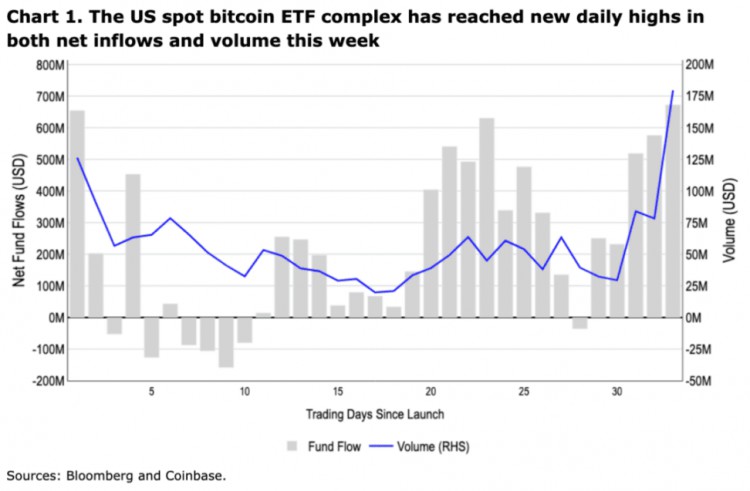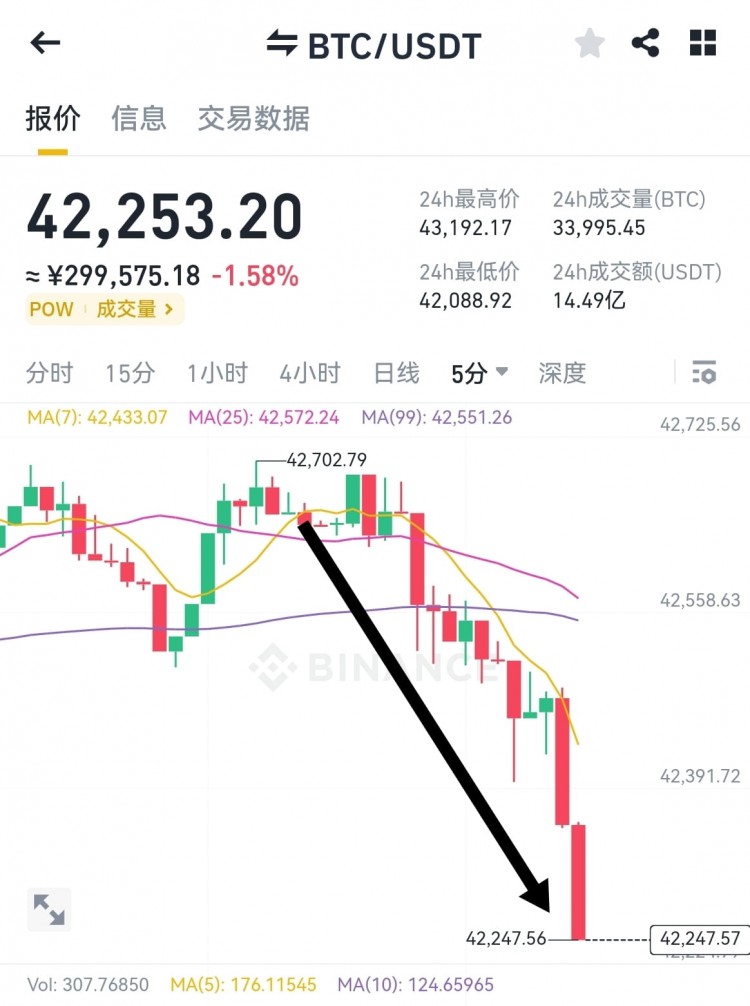时间:2024-03-04|浏览:307
Written by: David Han, David Duong
Compiled by: DAOSquare
Highlights
Crypto markets’ rebound this week has been supported by massive inflows into U.S. spot Bitcoin ETFs and a short squeeze on leveraged derivatives positions. Open interest reached its highest level since January 2022, and funding rates surged to their highest level since April 2021 (109% annualized).
The proposal put forward by the Uniswap Foundation on February 23 lays the technical foundation for the implementation of a fee mechanism for paying UNI stakers and delegators (participating in governance) in wETH.
We believe that the conversation about blockchain adoption will shift from scalability to how to create a silky user experience, which means not only the abstraction of the underlying blockchain, but also about pain points such as mnemonics, wallet management, etc.
market observation
The Crypto market’s impressive rally this week was supported by a combination of massive inflows into U.S. spot Bitcoin ETFs and a short squeeze on leveraged derivatives positions. Spot Bitcoin ETFs received staggering net inflows of nearly $1.8 billion in the first three days of the week, with BlackRock’s iShares Bitcoin ETF (IBIT) alone accounting for 70% of that (see chart 1). While many large broker-dealers, such as Morgan Stanley, are still conducting due diligence on these products - a prerequisite for offering them to clients - there's certainly something encouraging to be seen from this week's performance.

Bitcoin price momentum has fueled a short squeeze in recent days, with open interest in BTC perpetual futures at its highest level since January 2022 ($14.2 billion). The weighted average funding rate for open interest reached an annualized rate of 109% on February 28, the highest level since April 2021, according to Glassnode data. Subsequently, the rate dropped to approximately 70% (see Figure 2). Nearly $750 million of shorts were liquidated between February 25 and 28, setting new highs for the number of shorts liquidated year-to-date. At the same time, we believe that short covering based on the futures long-short ratio may be coming to an end but is not yet fully complete.
Recent performance remains consistent with the constructive outlook we issued in early February, but we are cautious about some negative seasonality that may still emerge in March. For example, traditional assets tend to be affected by drivers such as tax payments, which can cause some temporary downward pressure. Large and sustained positive moves in funding rates and open interest could also have an impact on the market if the liquidation of funding rates and open interest results in a cascade of long liquidations. Nonetheless, we remain generally constructive on the outlook for the coming months, as a large number of wealth managers will also continue to include spot ETFs, with such net inflows clearly absorbing the circulating supply of liquidity faster than Bitcoin miners can produce it. Faster.

On-chain: Uniswap fee switching
On February 23, the Uniswap Foundation (UF) announced a proposal to upgrade the governance of the Uniswap V3 protocol to award a portion of transaction fees to UNI token delegators and stakers. However, it should be noted that the proposal itself does not enable fee conversion, but rather sets out a technical mechanism for how to implement fee conversion. If the proposal passes, the initial fee parameter will be set to 0, but a range of 10% to 20% of transaction fees can be used for reward programs in future proposals.
In our view, the biggest concern about enabling protocol fees is the impact on liquidity providers, as any such fees will be deducted from their revenue. This may result in a reduction in Total Value Locked (TVL) and MEV-based traffic. A detailed analysis by Gauntlet (involved with UF) addresses this question and suggests that the impact on core non-MEV volumes is likely to be minimal, with annual revenue estimates ranging from a conservative $10 million to an optimistic $72 million based on historical activity. If this initial proposal passes, the Gauntlet team will also be responsible for coming up with a fee rollout plan.
We believe that this proposal is likely to be implemented given that it has been proposed by UF's governance leaders and has received broad support in the forum. In fact, in the previous fee proposal that was rejected in June 2023, most participants expressed approval, but the voting differences between different fee levels ultimately made "no fee" the majority. Given that the proposal has not yet changed any revenue structures and does not present the same vote distribution issues, we do not see any significant obstacles. Interestingly, the proposal also links revenue to governance (through staking and delegation), which we believe could incentivize more active community participation by UNI holders. The voting period for the proposal is expected to take place between March 1 and 7.
The widespread interest in the proposal has led several other projects to consider following suit, such as Frax. If this trend develops in other mature DeFi protocols, we think it may start to bring previously speculative token valuations into a clear and actually supported valuation model, especially for those that can generate sustainable Fee tokens and protocols. At the same time, this shift also represents a change in the protocol's value accrual mechanism, as it rewards agents and stakers directly with wETH (the current proposed payment token), unlike other protocols such as MakerDAO that use native token buyback and destruction. The mechanics contrast.
On-chain: The proliferation of application chains
Additionally, we’d like to discuss the growing rollup space on Ethereum, which has given rise to a new class of rollup-as-a-service (RaaS) products that allow creating and deploying rollups with simple clicks. The development of modular blockchains has accelerated with the emergence of various technologies and is used to deploy Layer2 (L2) and other application-specific chains. The aforementioned Frax protocol plans to launch its own L2 Fraxtal, which will make it part of the Optimism superchain. Other major protocols, such as decentralized perpetual contract exchange GMX, currently the top TVL protocol on Arbitrum, are also considering deploying their own chains (it is currently known that the GMX protocol will remain on Arbitrum and Avalanche C-Chain superior).
As more and more L2s are born, we believe that there will be more scrutiny in the field of cross-chain bridges and interoperability, and the complexity of the entire ecosystem will also increase, with different solutions making different assumptions about security, confirmation time, and development. There are timetable and cost considerations, which may also pose obstacles for non-technical end users. In addition, the fixed cost of Rollup (the cost of gas for the Layer1 infrastructure layer) is also a factor to consider. In a world where L2 proliferates, monetization may become increasingly difficult and will likely push applications further into Layer 3, which in turn will lead to a reshuffling of profitable L2 chains. This fragmentation of the execution environment has led some critics to argue that the shared state provided by a single or integrated blockchain enables more use cases and better cross-application security.
The discussion of both approaches to scalability, both for and against the arguments, has far-reaching implications, although we argue that these technical trade-offs are actually secondary to building a smooth user experience. . In our view, widespread adoption of any application will ultimately require the abstraction of technical complexity from the consumer, just as the underlying technology stack (and design trade-offs) of a large web2 platform are largely user-agnostic. With this in mind, we believe technology that enables users to protect their wallets with passkeys, such as Coinbase’s wallet solution, is even more important to growing the Crypto market. Although these tools are often overlooked in the scalability debate, we believe these innovations could ultimately have a huge impact on user adoption and new acquisitions, especially if scalability solutions converge to similar performance over the long term.
Crypto and traditional domain performance

(As of February 29, 4 p.m. ET)
Coinbase Exchange and CES Insights
BTC’s rally continues to surprise many market participants with its strength. Long holders are benefiting from this momentum, as more than $2 billion in new money entered ETF products over the past week. Still, high funding rates and rising open interest in perpetual futures products could pose risks to the rally. Over the past seven days, funding rates have averaged over 30%, making it costly to hold long exposure. Altcoin flows have shown a closer correlation with investor trading behavior around sectors and narratives.
Coinbase platform trading volume (USD)

Coinbase platform trading volume (proportion of assets)

funding rate

Notable Crypto News
mechanism
VanEck launches NFT platform to offer token-run watch and wine ownership splits by March (The Block)
Ledn launches Ethereum-backed lending service and accepts former Celsius users (The Block)
Supervision
Elizabeth Warren is willing to “collaborate” with the crypto industry (but reiterates that traditional financial rules must be followed) (The Block)
Hong Kong Ends Cryptocurrency Exchange License Application Campaign (Cointelegraph)
conventional
Ethereum NFT Card Game “Gods Unchained” Launches on iOS and Android (Decrypt)
Coinbase
Coinbase Announces Support for Asset Recovery on BNB Smart Chain and Polygon (Coinbase Blog)
Coinbase Cloud adds support for Nethermind and Erigon to increase diversity of Ethereum execution clients (Coinbase Blog)
The growing wallet industry will help bring a billion users on-chain (Coinbase Blog)
global vision
Europe
ECB official says: Bitcoin’s fair value remains zero (ECB blog) (Decrypt)
Paris Saint-Germain becomes first football team to verify blockchain (CoinDesk)
England Law Commission seeks comments on draft legislation to label cryptocurrencies as property (CoinDesk)
Asia
Major Japanese companies Mitsubishi UFJ, Rakuten, and Mizuho will launch security tokens (Cryptonews)
The Hong Kong Monetary Authority issues a circular on the sale and distribution of tokenized products (HKMA)
Hong Kong’s Financial Secretary said that Hong Kong will launch a regulatory sandbox (The Block) for stablecoin issuers
Big events for the week ahead


用戶喜愛的交易所

已有账号登陆后会弹出下载


![[艾略特]Telefónica 通过分散式移动基础设施扩大覆盖范围](/img/btc/129.jpeg)






